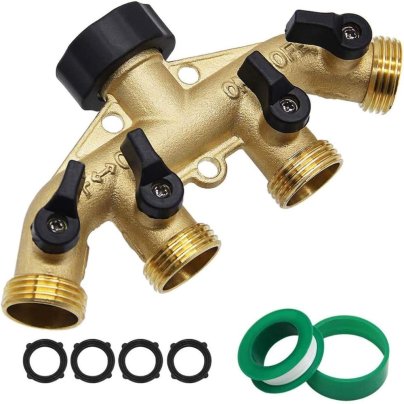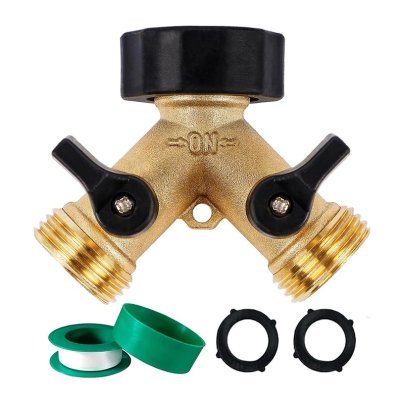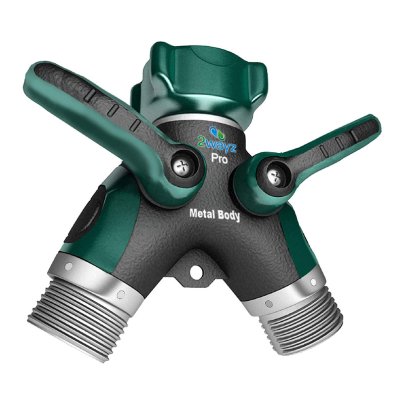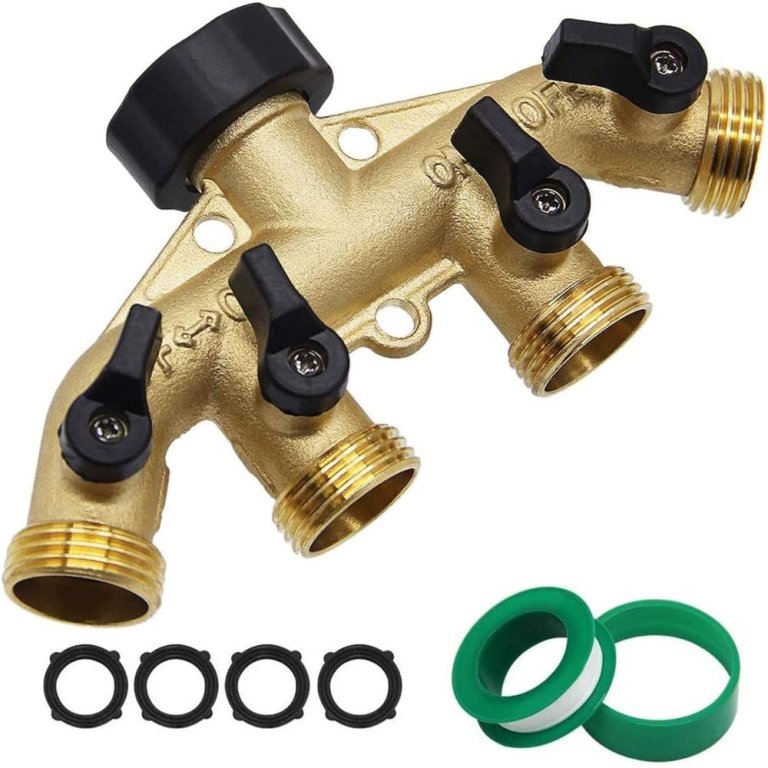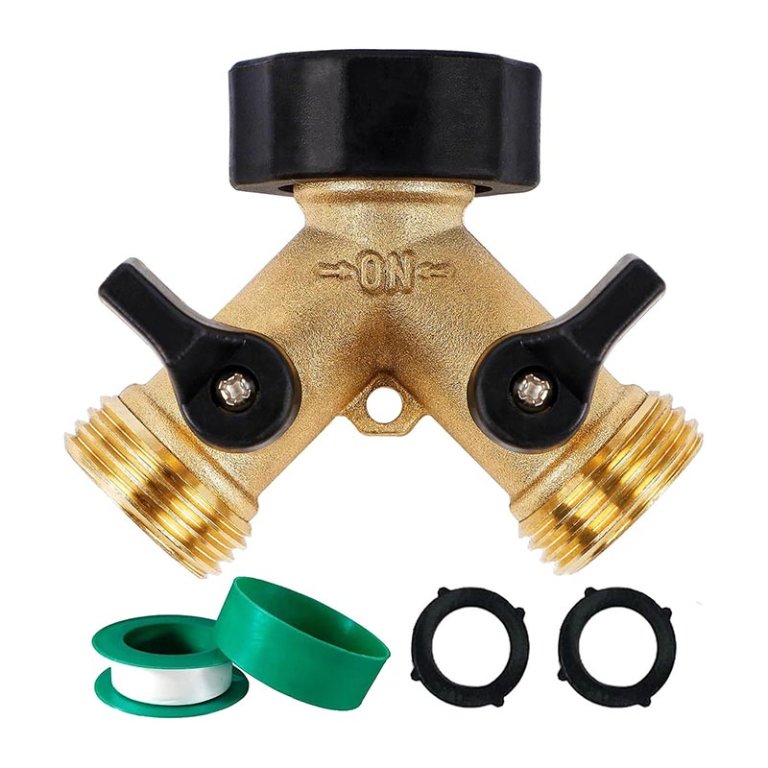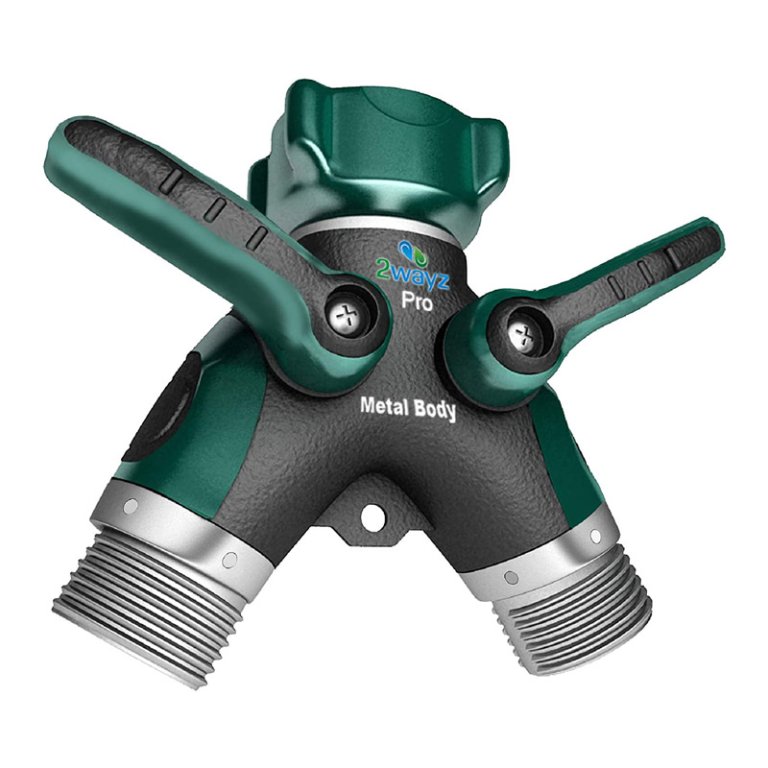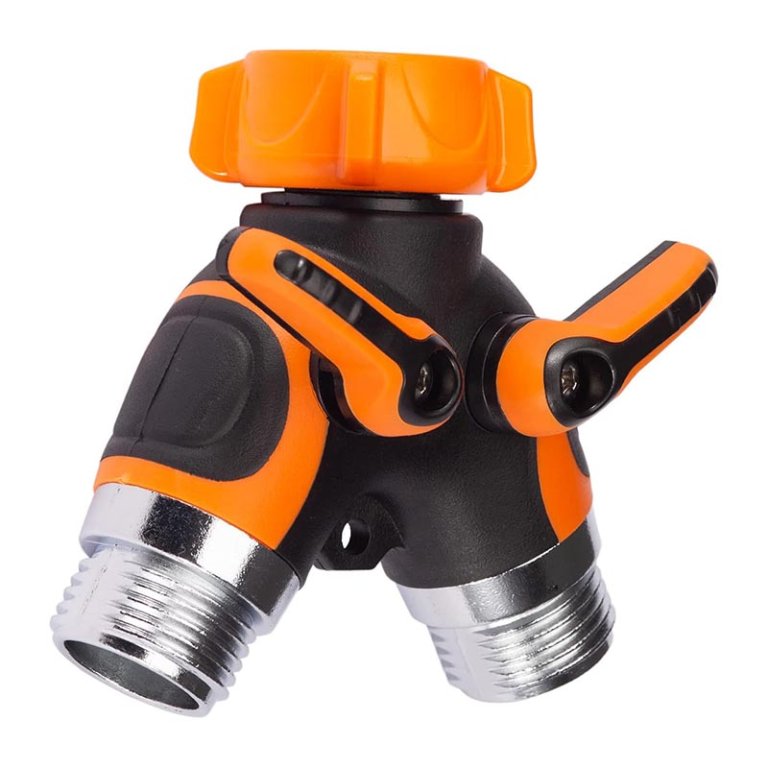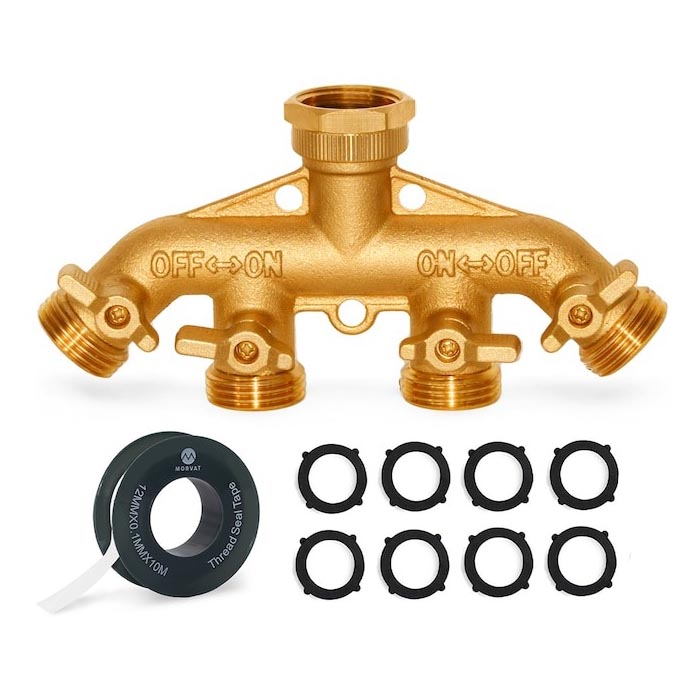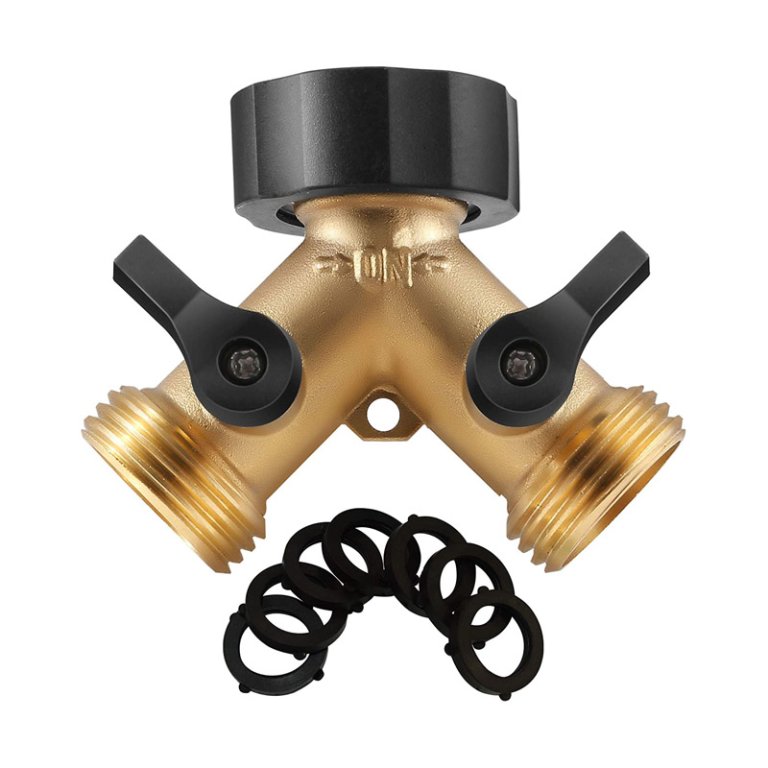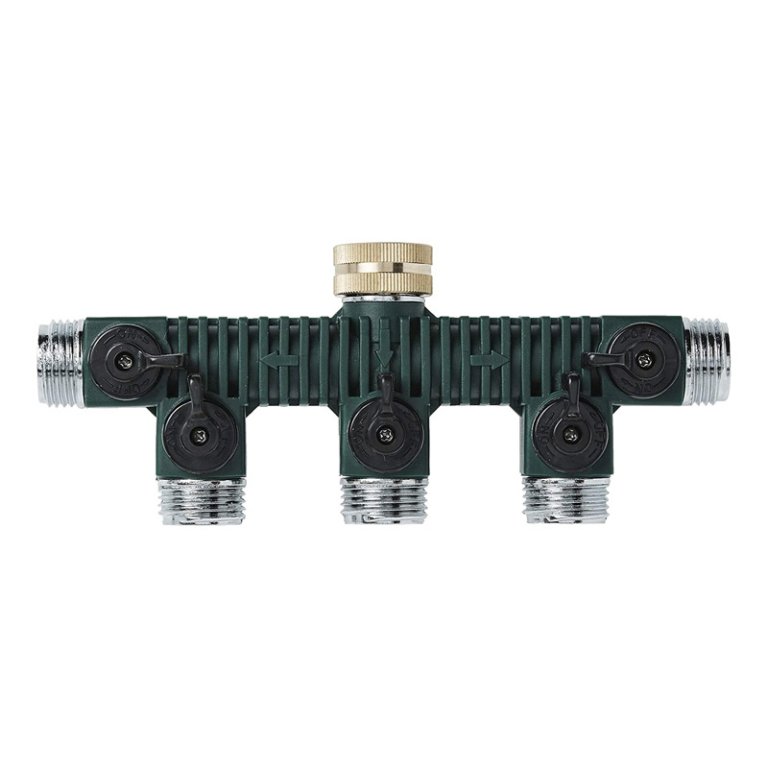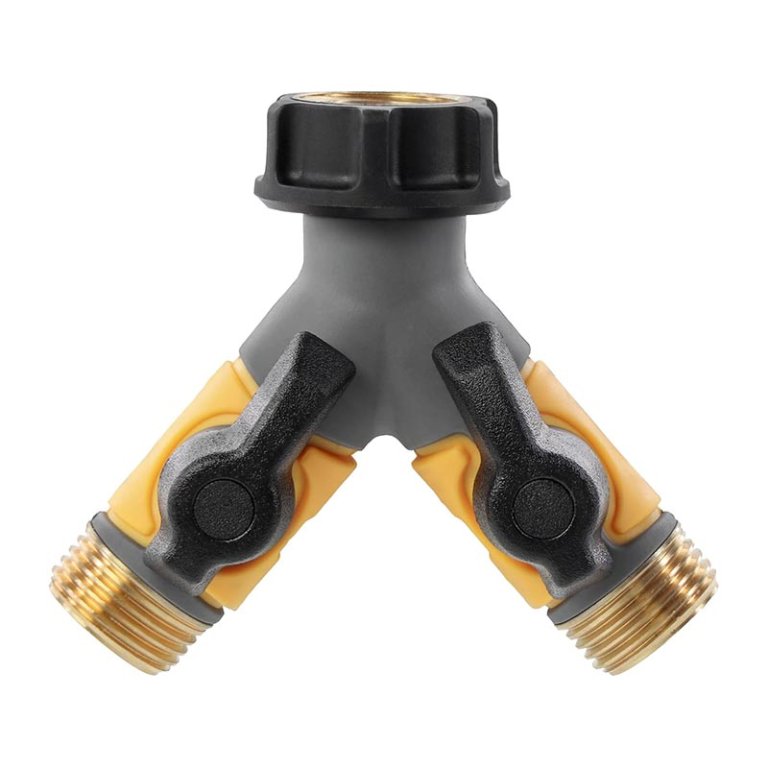
We may earn revenue from the products available on this page and participate in affiliate programs. Learn More ›
If that single outdoor spigot simply isn’t enough to handle your water demands, then consider adding a garden hose splitter. These handy garden hose attachments turn a single spigot into two or more water channels, so gardeners no longer have to drag sprinklers from place to place or constantly rotate which part of the yard gets watered. With a garden hose splitter, you can water plants while someone else washes the car or power washes the patio.
We put five hose splitters through rigorous testing to find leak-proof models that split a single spigot into two to four channels while maintaining a steady water flow to each. We hooked up multiple sprinklers to find out which splitters perform the best.
When we finally closed the valve on our last contender, the Twinkle Star Heavy-Duty Brass Garden Hose Splitter emerged as our best overall pick because of its durable all-metal construction and four faucets with rubberized on/off switches.
Ahead, we break down our findings on the Twinkle Star hose splitter and the other four gardening hose attachments we tested, and recommend three additional models. We also cover the factors to consider when shopping for one of the best garden hose splitters.
- BEST OVERALL: Twinkle Star Heavy-Duty Brass Garden Hose Splitter
↓ Jump to Review - BEST BANG FOR THE BUCK: Biswing Garden 2-Way Brass Hose Splitter
↓ Jump to Review - BEST USER-FRIENDLY: 2wayz 2-Way Heavy-Duty Garden Hose Splitter
↓ Jump to Review - BEST VERSATILE: Giraffe Tools Garden 2-Way Hose Splitter
↓ Jump to Review - BEST FOUR-WAY: Morvat Brass 4-Way Full-Flow Water Shut-Off
↓ Jump to Review - BEST DURABLE: Ipow 2-Way Heavy-Duty Y-Valve Garden Hose Splitter
↓ Jump to Review - BEST HIGH-CAPACITY: Orbit Zinc 5-Way Shut-Off Valve Hose Manifold
↓ Jump to Review - ALSO CONSIDER: Solterra Garden Hose Y With Shutoffs
↓ Jump to Review
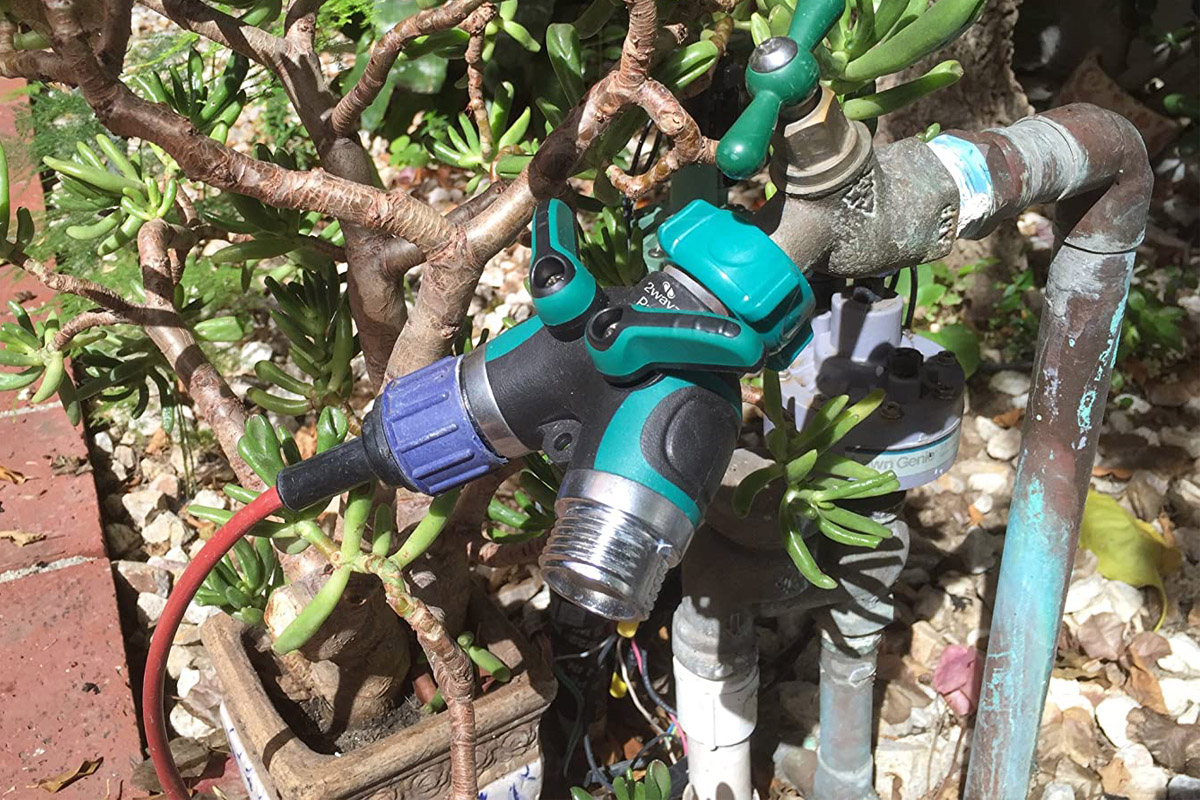
Garden Hose Splitters Comparison Chart
| Product | Material | Faucets | Features |
| Twinkle Star Heavy-Duty Brass Garden Hose Splitter | Brass | 4 | 4 on/off switches, 4 O-rings, and thread seal tape |
| Biswing Garden 2-Way Brass Hose Splitter | Brass | 2 | Rubberized tightening nut and valve handles |
| 2wayz 2-Way Heavy-Duty Garden Hose Splitter | Zinc and aluminum alloy | 2 | Large valve handles, rubberized coating |
| Giraffe Tools Garden 2-Way Hose Splitter | Zinc, rubber, plastic | 2 | Rubberized coating, large handles |
| Morvat Brass 4-Way Full-Flow Water Shut-Off | Brass | 4 | All-metal construction |
| Ipow 2-Way Heavy-Duty Y-Valve Garden Hose Splitter | Brass and thermoplastic rubber | 2 | 6 rubber washers and 2 thermoplastic rubber on/off switches |
| Orbit Zinc 5-Way Shut-Off Valve Hose Manifold | Zinc, brass, and plastic | 5 | 5 on/off switches on each faucet |
| Solterra Garden Hose Y With Shutoffs | Brass, metal, and rubber | 2 | 2 on/off switches |
Our Top Picks
Finding the best garden hose splitter means identifying the proper construction material, spigot compatibility, and number of channels to fit the existing hose outlet. Here are the top picks to help take some of the guesswork out of finding the right splitter for the job. The following are some of the best garden hose splitters on the market based on durability, size, and construction quality.
Best Overall
Twinkle Star Heavy-Duty Brass Garden Hose Splitter
What We Like
- All brass construction gives it a sturdy feel
- Easy-grip rubber coatings on the tightening nut and switch
- Doesn’t restrict water flow from the spigot
What We Don’t Like
- Small switches can be hard to turn
Specs
- Material Brass
- Faucets 4
- Features 4 on/off switches, 4 O-rings, and thread seal tape
Our Ratings
| Ease of Use | 4/5 | Functionality | 5/5 | Durability | 4/5 | Value | 5/5 |
The Twinkle Star garden hose quadruples the service available from a single spigot with a design that’s both user-friendly and durable. It splits the spigot into four male hose connectors, making it ideal for watering plants and lawns, running irrigation, and even power-washing multiple vehicles at a time.
The splitter’s female hose fitting and switches have a rubberized coating, which allowed us to hand-tighten the splitter to the spigot without needing pliers. Though the splitter’s valve switches are small, their rubber coatings allowed us to work them even with wet hands. We also liked the large on-off labels just above the valves.
Water flow is excellent with this four-valve splitter. We experienced no leaks during testing and had no problems generating enough pressure for our sprinkler and sprayer nozzle.
Along with its solid performance, the Twinkle Star also has excellent build quality. With its brass construction and metal ball valves, this hose splitter has a sturdier feel than other four-way splitters we tested, which used softer metals and plastic components. It’s truly a hose splitter that’s built to last.
What our tester says: “This hose splitter is tough enough to endure harsh weather and constant use, with features that make it easy to use.”—Tony Carrick, Product Reviews tester and writer
Get the Twinkle Star garden hose splitter at Amazon.
Best Bang for the Buck
Biswing Garden 2-Way Brass Hose Splitter
What We Like
- Durable all-metal construction
- Easy-to-operate rubberized tightening nut
- Doesn’t restrict water flow from spigot
What We Don’t Like
- Small valve handles are hard to turn
Specs
- Material Brass
- Faucets 2
- Features Rubberized tightening nut and valve handles
Our Ratings
| Ease of Use | 4/5 | Functionality | 4.5/5 | Durability | 5/5 | Value | 5/5 |
This durably made two-way splitter is an affordable way to double the duty of a spigot. Despite being one of the more affordable hose splitters we tested, it’s very well made with all-brass construction and metal ball valves
With a rubberized coating on the tightening nut, we were able to get a firm grip on it when hand-tightening it onto a spigot. The valve handles also have a rubber coating that made them easier to grip, though their small size makes them harder to turn than the two-way splitters we tested with larger switches. There’s also a helpful “on” label just below the collar, which takes the guesswork out of determining whether a valve is open or closed.
With its heavy-duty brass construction, which includes brass ball valves, the Biswing splitter feels like it could survive many seasons without leaking. We tested it with a sprinkler and a handheld sprayer and didn’t notice any drop in water pressure when using each individually or both together. The valves also effectively cut off the flow of water with no leaks around the tightening nut or from either valve.
Get the Biswing garden hose splitter at Amazon.
Best User-Friendly
2wayz 2-Way Heavy-Duty Garden Hose Splitter
What We Like
- Large switches make it easy to operate
- Easy-to- install design
- Great water flow rate
What We Don’t Like
- Zinc alloy and plastic components aren’t as strong as brass
Specs
- Material Zinc and aluminum alloy
- Faucets 2
- Features Large valve handles, rubberized coating
Our Ratings
| Ease of Use | 4.5/5 | Functionality | 5/5 | Durability | 4/5 | Value | 4.7/5 |
The 2wayz hose splitter’s larger size and ample rubberized coating made it both easy to install and operate. The splitter’s valve switches are about twice as long as those of other hose splitters we tested, which made opening and closing the valves easier than with the smaller switches of other splitters we tested. There’s also a plastic cuff around the tightening nut that makes it easy to hand-tighten the splitter to the spigot. However, we wouldn’t attempt to tighten it with pliers, as that could damage it.
The 2wayz splitter also performed well during testing, with no noticeable decrease in water flow.
While we liked the user-friendly design and performance of this splitter, we did have some durability concerns. The 2wayz splitter is made from zinc, which, though certainly durable, isn’t as tough as brass. We also noticed that the ball valves are made of plastic, as opposed to metal. While we didn’t experience any leaks during testing, we wondered if these plastic parts would hold up as well as splitters with all-brass construction and metal ball valves.
Get the 2Wayz garden hose splitter at Amazon or Walmart.
Best Versatile
Giraffe Tools Garden 2-Way Hose Splitter
What We Like
- Large rubber-coated handles are easy to operate
- Brightly colored body is easy to spot
- Doesn’t restrict water flow
What We Don’t Like
- Not as durable as brass
Specs
- Material Zinc, rubber, plastic
- Faucets 2
- Features Large valve handles, rubberized coating
Our Ratings
| Ease of Use | 5/5 | Functionality | 5/5 | Durability | 4/5 | Value | 4.5/5 |
Giraffe Tool’s brightly colored hose splitter is a good choice for use at the spigot or further down the line to split a single hose into two hoses. The large body, rubberized grip, and plastic cuff around the tightening nut made it easy to install, whether we were attaching it to a spigot or a hose. And with its bright orange color, it was easy to spot in the grass, something we appreciated when using it to split two hoses in the yard to operate both a sprinkler and a handheld sprayer.
We also like the rubber-coated large valve switches that made turning each valve on and off easier on the fingers than those with smaller switches.
The Giraffe splitter’s performance matched other splitters we tested, with no noticeable decline in water pressure after adding it to our spigot.
Our one concern with the Giraffe Tools splitter is its durability. While we didn’t experience any leaks during testing, we wondered how long the zinc alloy body and plastic ball valve would last compared to splitters with brass construction and metal ball valves.
What our tester says: “I can operate the large switches on this garden hose splitter without having to take my work gloves off.”—Tony Carrick, Product Reviews tester and writer
Get the Giraffe Tools garden hose splitter at Amazon.
Best Four-Way
Morvat Brass 4-Way Full-Flow Water Shut-Off
What We Like
- Durable all-metal construction
- Excellent water flow
- On/off labels for valve switches
What We Don’t Like
- Small valve switches can be hard to turn
Specs
- Material Brass
- Faucets 4
- Features All-metal construction
Our Ratings
| Ease of Use | 4/5 | Functionality | 4.5/5 | Durabililty | 5/5 | Value | 5/5 |
Morvat’s four-way splitter is one of the toughest hose splitters we tested. It consists of all-brass construction, including the individual valve handles, ball valves, and female connector for the spigot.
We tested this four-way splitter with a sprinkler and handheld sprayer and experienced no drop in water pressure. Similar to other brass splitters we tested, the Morvat four-way splitter has convenient labels with arrows designating the on and off directions for the valves.
While we liked the rock-solid construction of this garden hose splitter, there are some downsides to its all-metal build. The Morvat’s small metal valve switches are harder on the fingers when opening and closing them. While we were still able to operate each valve without too much difficulty, it may be a challenge for some. The Morvat splitter also uses a hexagonal tightening nut, which made it difficult to hand-tighten it into the spigot. While this type of nut allows for a tighter connection by using a crescent wrench, it’s less convenient.
Get the Morvat garden hose splitter at Lowe’s.
More Great Options
Along with those hose splitters we tested, we also recommend the models below.
Best Durable
Ipow 2-Way Heavy-Duty Y-Valve Garden Hose Splitter
What We Like
- Heavy-duty brass construction
- 2 thermoplastic rubber on/off switches
- Fits all standard faucets and garden hoses
- 6 rubber washers are included
What We Don’t Like
- Levers can be quite stiff to operate
Specs
- Material Brass and thermoplastic rubber
- Faucets 2
- Features 6 rubber washers and 2 thermoplastic rubber on/off switches
This all-brass garden hose splitter from Ipow attaches quickly to standard spigots and hoses. Wide on/off handles make regulating water flow easy and comfortable. Ipow built these splitters for use both in the garden and indoors, and each unit comes with six rubber washers to create a seal that prevents leaks.
The handles are coated with a thermoplastic rubber that is easy to grip when adjusting the water flow. A threaded plastic collar secures to the spigot, and brass construction resists corrosion. This dual splitter from Ipow represents an excellent combination of functionality and durability.
Get the Ipow garden hose splitter at Amazon or Walmart.
Best High-Capacity
Orbit Zinc 5-Way Shut-Off Valve Hose Manifold
What We Like
- 5 streams of water with 2 extra ports on the sides
- Made of zinc, brass, and plastic
- Tight ball valves prevent any leaks or wasted water
What We Don’t Like
- Components can wear over time
- Zinc can corrode
Specs
- Material Zinc, brass, and plastic
- Faucets 5
- Features 5 on/off switches
Orbit takes garden hose splitters to the next level by offering a product that can split one spigot into a whopping five streams of water. The three ports on the bottom are equipped with shut-off valves for individual control of water streams. Orbit shines with the inclusion of two additional ports on either side of the apparatus, allowing for two extra hoses without the independent shutoff.
The two extra hoses operate as though attached directly to the spigot. Constructed from zinc with a plastic cover and a brass swivel head, this durable hose splitter features a swivel capability that protects against hose breakage when tugged on. This splitter is best for permanent installation, as zinc can corrode, making it difficult to remove.
Get the Orbit garden hose splitter at Amazon or Walmart.
Also Consider
Solterra Garden Hose Y With Shutoffs
What We Like
- Includes a rubber cover for durability
- Suitable for a wide range of gardening needs
- Each faucet comes with a shut-off valve
What We Don’t Like
- Handles may be difficult to adjust with gloves
Specs
- Material Brass, metal, and rubber
- Faucets 2
- Features 2 on/off switches
With a rubber-coated brass body, this hose splitter from Solterra can endure regular wear and tear in a variety of weather conditions. The male-threaded connections swivel, so pulling on the hose from across the yard will not damage the splitter or cause leaks. Its ball valves help prevent leaks, and sturdy plastic shut-off valves adjust with just the push of a thumb, though their small size may be difficult to manipulate while wearing gloves.
Get the Solterra garden hose splitter at Amazon.
Jump to Our Top Picks
How We Chose and Tested the Best Garden Hose Splitters
We took several factors into account when selecting the best garden hose splitters. We put five of the hose splitters to the test by using them in our own yard.
We hooked them up to a spigot, evaluating how easy each splitter was to install, then proceeded to put each one through a series of tests. We began with assessing water flow by opening and closing each valve on each splitter and observing how evenly water was distributed through each valve. While conducting this test, we considered how easy it was to open and close each valve switch.
We then added multiple hoses and various water receptacles, including sprinklers and handheld sprayers. We ran a sprinkler for 30 minutes with each splitter, measuring the coverage area to determine if it restricted the water flow. Finally, we conducted a thorough check for leaks on each valve and at the connection between the splitter and spigot.
We also considered the base material to find the best garden hose splitter. Most splitters are made from plastic and metal. While plastic splitters are light and durable, they do not provide the same longevity as metal splitters and can deform when exposed to hot water or high temperatures.
Other factors we considered were cost, the number of hose channels the splitter had, and each one’s estimated longevity. We selected the splitters we didn’t test by using our experience from previous tests, while also comparing specs and user reviews.
| Product | Ease of Use | Functionality | Durability | Value |
| Twinkle Star Heavy-Duty Brass Garden Hose Splitter | 4/5 | 5/5 | 4/5 | 5/5 |
| Biswing Garden 2-Way Brass Hose Splitter | 4/5 | 4.5/5 | 5/5 | 5/5 |
| 2wayz 2-Way Heavy-Duty Garden Hose Splitter | 4.5/5 | 5/5 | 4/5 | 4.7/5 |
| Giraffe Tools Garden 2-Way Hose Splitter | 5/5 | 5/5 | 4/5 | 4.5/5 |
| Morvat Brass 4-Way Full-Flow Water Shut-Off | 4/5 | 4.5/5 | 5/5 | 5/5 |
What to Consider When Choosing a Garden Hose Splitter
Identifying the best garden hose splitters requires taking several factors into account. Features like size, material, and the number of channels dictate the effectiveness of a multihose setup. Read on to learn more about selecting the best hose splitter for a garden.
Compatibility and Size
At first glance, garden hoses tend to look like they’re the same size, but the reality is that they have different-size fittings. The proper fitting size for a garden hose splitter matches the threads of a garden hose, ensuring a secure fit and preventing leakage. Most garden hose fittings have a standard external diameter of 1 1/16 inches, but the inner diameter may vary depending on the hose’s circumference and thickness.
The hose circumference usually matches the connector size. Water hose connectors include ⅜-, ½-, and ¾-inch fittings. Determining the proper size is easy: Simply use a tape measure to determine the diameter of the hose opening. That number corresponds to the size of the garden hose connector required for that hose.
Material
The two most frequently-used materials in garden hose splitters are plastic and metal. Plastic splitters are light, durable, and sturdy. Well-constructed plastic splitters usually incorporate metal parts, which more effectively resist the corrosion associated with constant exposure to water. When planning to frequently move the splitter between taps, plastic is preferable, as the threads won’t seize since they don’t rust.
Though durable and sturdy, plastic splitters do not provide the same toughness and longevity as metal splitters, and they may melt or deform when exposed to high temperatures. Red metals like brass, bronze, and copper are best due to their low iron content. Less iron translates to reduced corrosion, but be aware that any metal splitter will ultimately begin to leak as it rusts.
Metal connectors for garden hoses can become stuck to the tap by rust, making them difficult to remove. Those using metal splitters will want to remove the hose after each use and be sure the tap is securely closed.
Number of Faucets
The purpose of a hose splitter is to provide multiple water faucets (sometimes referred to as channels or outlets), and two is not the limit. By definition, a hose splitter turns one stream of water into two, but more options are available. Splitters with three faucets are very popular for their added utility, and there are even four-faucet splitters on the market.
Water pressure can be an issue with multi-faucet splitters. Dual splitters usually work well with both high and low pressure, but adding a third faucet may result in three streams of water that are too weak to be useful. If a four-channel splitter is necessary, the tap must have excellent water pressure to maintain the integrity and strength of the stream.
Ease of Use
Hose splitters make it easier to control where water goes, and some options include plenty of user-friendly features. Here are some of the best things to look for that help these products stand out:
- Spigots and on/off valves: Spigots or on/off valves allow individual outlets to be turned on and off, allocating water where it is needed. Most hose splitters with this feature have one spigot per faucet for the best control.
- Threaded connections: Threaded garden hose connections provide a tight water seal and prevent water waste and leakage. Female hose connectors with threaded designs easily connect to existing garden hoses.
- O-rings and washers: O-rings and washers help maintain a watertight seal when attaching a garden hose.
- Tape: Thread seal tape, Teflon tape, or plumbers tape is helpful when a garden hose splitter is a permanent fixture as tape can help keep any potential leaks at bay. This kind of tape is also suitable for kitchen and bathroom faucet varieties.
The Advantages of Owning a Garden Hose Splitter
Garden hose splitters add utility to many household and garden-related operations. Need to wash the car while the sprinkler waters the lawn? A splitter makes that possible. Perhaps two separate areas of the yard require simultaneous irrigation, in which case hooking up a splitter can direct water into multiple places at once. Additionally, those who use hose timers may also need a full-time hose hooked to a spigot.
The best garden hose splitters make operations like drip irrigation easy. Drip irrigation allows water to drip slowly into the root systems of plants from a finely perforated hose. Because the process is slow and ongoing, it often requires full-time hose use. Splitters allow gardeners to hook up a separate hose for other tasks.
Soaker hoses are often used to irrigate gardens as well. A soaker operation requires poking several holes in the hose, which can make for an unpleasant surprise when a user accidentally grabs a single connected soaker hose to wash the dog. Splitters make it possible to keep a fully functional hose at hand while the other intentionally leaks—in fact, splitters can keep a second, third, or fourth hose free for other uses.
- Garden hose splitters allow operation of multiple hoses from a single spigot.
- Dedicated irrigation systems that require full-time use of a hose will not prevent operators from using hoses for other purposes.
- Garden splitters provide easy-to-use shut-off valves that prevent water loss through leakage.
Tips on Using a Garden Hose Splitter
Installing and using a garden hose splitter is pretty straightforward, but there are a few tips to keep in mind. Cold weather can cause water trapped in the splitter or hose to freeze. Frozen water expands, sometimes resulting in burst pipes or damaged equipment. If you live in an area that experiences low temperatures, be sure to uninstall the splitter and the hoses for the winter months or drain them after turning off the water supply inside.
When installing a garden hose splitter or a hose, use firm but gentle pressure to hand-tighten the socket. Applying too much force will result in damaged parts, which can destroy the integrity of the connection. Check out some more tips below.
- When using a metal garden hose splitter, ensure that the hose is disconnected and the water is fully shut off after each use to avoid corrosion.
- Check the water pressure before buying a splitter. Dual garden hose splitters work well with normal water pressure that ranges from 40 to 60 pounds per square inch (PSI), but weak water pressure or too many outlets can prevent them from functioning properly.
- Try to buy a splitter with a large and comfortable grip. This provides easy operation and prevents leakage.
FAQs
There are several factors to consider when choosing the best garden hose splitter. For quick reference to your most pressing queries, check out the answers to the following frequently asked questions.
Garden hose attachments are not universal, but most standard garden hoses on the market are made with fittings that fit as many outdoor watering products as possible, including fountains, outdoor pools, or hose nozzles.
Male hose connectors have a pin that fits a hole on the splitter, while female connectors accept the pin from the male end. Examine the spigot before purchase to purchase the right one.
Garden hoses have a narrower circumference than washing machine hoses. Hooking up a garden hose to a washing machine may result in engine burnout, as there probably is not enough water moving through the machine.
If high pressure is needed, choosing a garden hose splitter with fewer outlets is optimal, as more faucets require more water dispersion. Another way to ensure that water is running at high pressure is to check for any leaks, twists, or blockages in the hose.
Gardeners can connect two garden hoses or expandable hoses together for added length. Compatible connectors or couplers will extend the reach of the hoses, though excessively long hoses may result in reduced water pressure.
Connecting two hoses of different sizes requires a water hose adapter. Determine the diameter of each hose with a tape measure and purchase a garden hose adapter that accommodates both.
There are many ways to properly store a garden hose. One option is to purchase a wall-mounted hose organizer or reel that keeps the hose untangled and organized. Another way is to roll up the hose and place it on a shelving unit in a shed, bench, or garage. These storage options will prevent damage such as kinks, cracks, and holes that would require you to repair your garden hose. Those who live in a cold climate should note that it’s important to make sure that the hoses are fully drained and dry before storing them for the winter.
Meet the Tester
Tony Carrick is a freelance writer specializing in home improvement, landscaping, technology, home security, and design. Carrick has conducted rigorous product testing on everything from power tools to home security systems to backyard grills.
Additional research provided by Mike Bruton.
